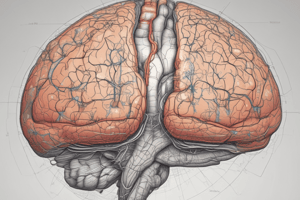Podcast
Questions and Answers
What is the primary difference between kinetic and static perimetry?
What is the primary difference between kinetic and static perimetry?
- The age of the patient being tested
- The type of target used for the test
- The distance between the examiner and the patient
- The movement of the target during the test (correct)
What is the purpose of the Amsler Grid Test?
What is the purpose of the Amsler Grid Test?
- To assess the patient's ability to see colors
- To detect visual field defects (correct)
- To examine the patient's eye movement
- To measure the distance between the eyes
What is Traquair's Island of Vision?
What is Traquair's Island of Vision?
- A concept of visual field that is based on the skill of the examiner (correct)
- A method of measuring visual field
- A type of visual field defect
- A type of perimetry
What is the main difference between the Confrontation Test and the Amsler Grid Test?
What is the main difference between the Confrontation Test and the Amsler Grid Test?
What is the primary purpose of perimetry?
What is the primary purpose of perimetry?
What is the typical distance between the patient and the test target during the Confrontation Test?
What is the typical distance between the patient and the test target during the Confrontation Test?
What does the Octopus Test measure?
What does the Octopus Test measure?
What does the G program in the Octopus Test stand for?
What does the G program in the Octopus Test stand for?
What is the purpose of charting the visual field in the Octopus Test?
What is the purpose of charting the visual field in the Octopus Test?
What is the name of the visual field defect that refers to the loss of vision in one eye?
What is the name of the visual field defect that refers to the loss of vision in one eye?
What is the type of visual field defect that refers to the loss of one half of the vertical visual field?
What is the type of visual field defect that refers to the loss of one half of the vertical visual field?
What is the term for the area where both the right and left monocular fields overlap?
What is the term for the area where both the right and left monocular fields overlap?
What is the approximate peripheral visual field in adults?
What is the approximate peripheral visual field in adults?
What is the reason for the different sizes of the monocular visual field?
What is the reason for the different sizes of the monocular visual field?
What is the location of the physiological scotoma or blind spot?
What is the location of the physiological scotoma or blind spot?
How does the visual field develop in newborns?
How does the visual field develop in newborns?
What is the purpose of dividing the visual field into nasal and temporal hemifields?
What is the purpose of dividing the visual field into nasal and temporal hemifields?
At what age do toddlers have a visual field similar to that of older kids and adults?
At what age do toddlers have a visual field similar to that of older kids and adults?
Flashcards are hidden until you start studying




